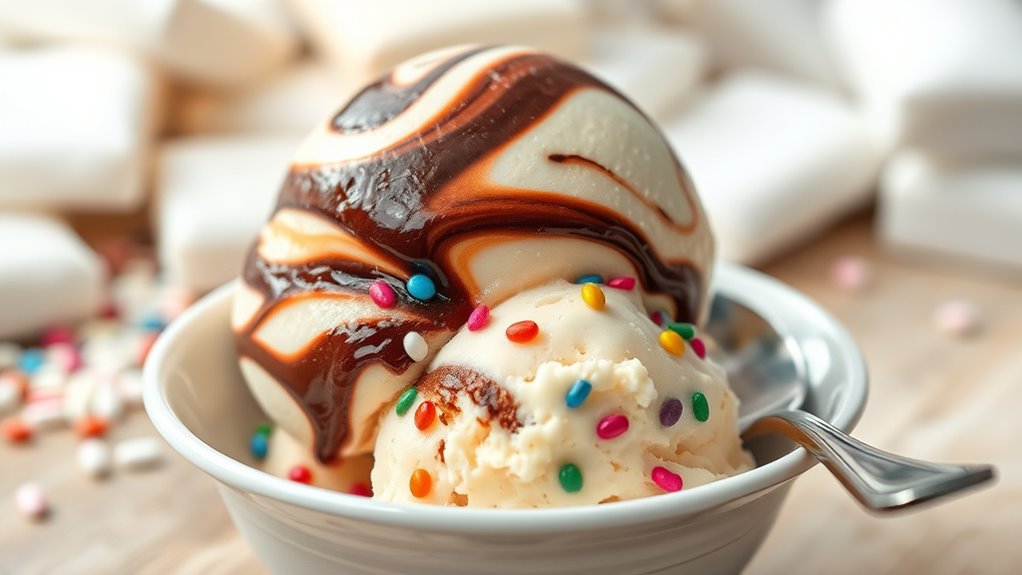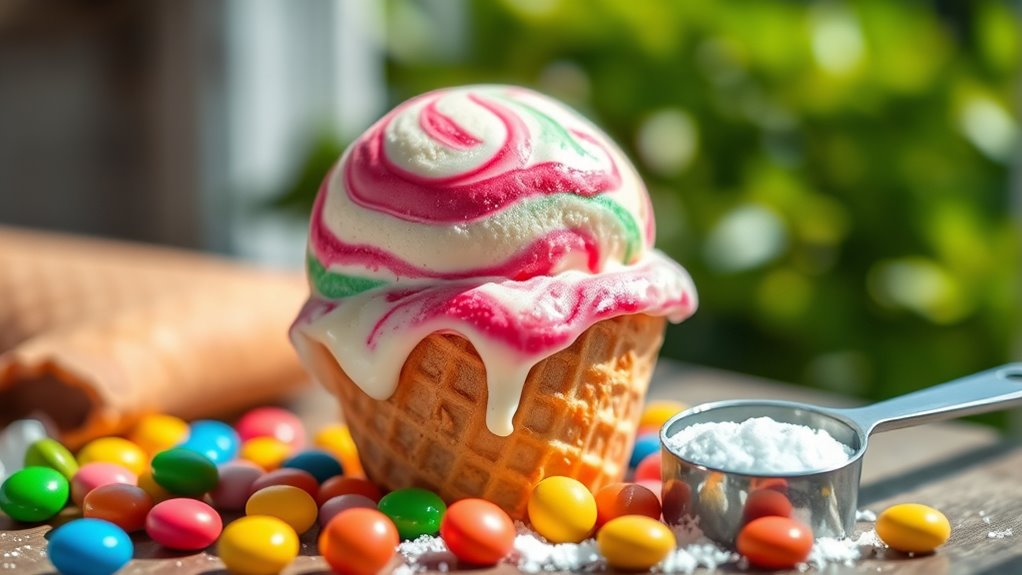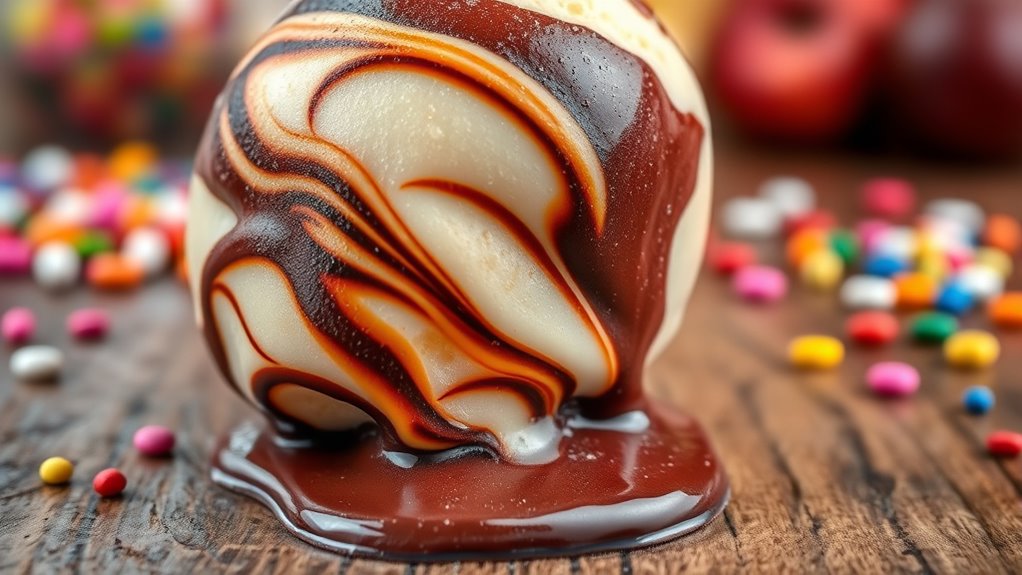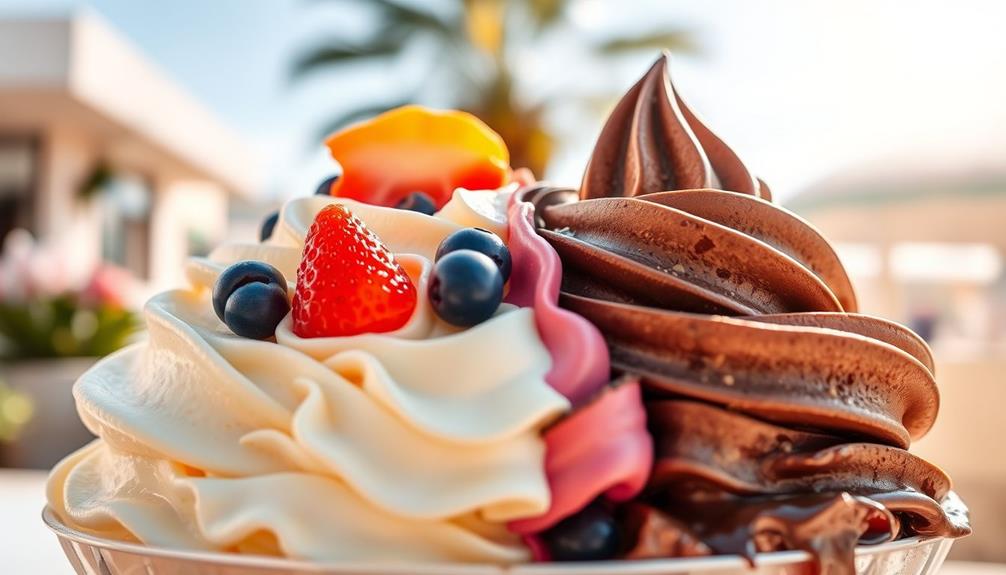Ice cream can pack a hefty amount of sugar, often exceeding daily limits in just one serving. Common flavors contain around 20-30 grams of sugar, which can contribute to health issues like obesity and heart disease. While indulgent, it’s essential to be mindful of your choices, as there are lower-calorie and low-sugar options available. Interested in what specific brands have the highest and lowest sugar content? You’ll discover more insights ahead.
Key Takeaways
- Ice cream recipes vary significantly in sugar content, impacting sweetness and texture with different types of sugars used.
- One cup of vanilla ice cream contains around 28g of sugar, nearing daily intake limits for many consumers.
- Popular brands can have up to 77g of sugar per pint, highlighting the importance of checking labels for healthier options.
- Reduced sugar and fat alternatives, such as Halo Top and Greek yogurt ice creams, offer lower-calorie choices for health-conscious consumers.
- Mindful eating and portion control are essential to balance enjoyment and health goals while consuming ice cream.
Understanding Sugar Variability in Ice Cream

When you plunge into the world of ice cream, you’ll quickly notice the significant variability in sugar content across different recipes.
Different sugars, like fructose or dextrose, can alter sweetness and texture, impacting how your ice cream melts and feels in your mouth. For instance, invert sugar enhances sweetness while keeping the texture smooth, often used in chocolate flavors. Additionally, a recipe that incorporates natural sweeteners can provide a healthier option without compromising taste. Many ice cream recipes also utilize frozen yogurt as a base to achieve a lighter, lower-calorie alternative. The popularity of vanilla as a flavor choice also influences sugar content, as many recipes aim to balance the sweetness to complement the creamy profile of this classic flavor.
Adding fruits contributes natural sugars, necessitating careful adjustments to avoid over-sweetening. Blending sucrose with other sweeteners, such as glucose syrup, allows for better control over flavor and texture.
While the dairy industry often aims for a 15% sugar level, consumer preferences can lean towards higher sweetness, showcasing the diverse landscape of ice cream recipes and their unique sugar profiles. Additionally, exploring global culinary delights can inspire new flavor combinations that elevate your ice cream creations.
Nutritional Breakdown of Vanilla Ice Cream

Understanding the sugar variability in ice cream sets the stage for exploring the nutritional breakdown of vanilla ice cream.
One cup typically contains around 273 calories, with about 15g of fat, primarily from saturated fats. You’ll find around 31g of carbohydrates in each serving, most of which comes from sugars, totaling over 28g. Additionally, it offers about 5g of protein. Essential oils can also provide natural alternatives for various health concerns, including those related to diet. Moreover, the high sugar content in ice cream can significantly impact heart health if consumed excessively. Incorporating fresh ingredients into desserts can enhance flavor and nutritional value, making them healthier options. For example, adding Dirt Cups as a dessert can be a fun and lower-sugar alternative that kids will love.
The macronutrient distribution is roughly 46% carbs, 48% fat, and 7% protein. Vanilla ice cream also provides essential nutrients like calcium (169mg), vitamin A (556 IU), and phosphorus (139mg).
Keep in mind that different brands may have varying formulations, affecting fat and sugar content, so always check labels for specifics. Consuming ice cream in moderation recommended is especially important for those concerned about cholesterol levels and heart health.
Health Considerations and Daily Sugar Intake

While enjoying ice cream can be a delightful experience, it’s important to be aware of the sugar content in these treats and its implications for your health.
Many popular brands contain 20-30 grams of sugar per serving, which can account for your daily limit of 25-30 grams of added sugars. Consuming high sugar amounts regularly can increase your risk of chronic conditions like obesity and heart disease. Additionally, being mindful of saturated fat intake can further support your overall heart health. Furthermore, high sugar consumption can also lead to increased inflammation in the body, further impacting your health. Moreover, some brands offer lower-calorie versions that cater to health-conscious consumers, providing a more mindful indulgence. Including foods high in dietary fiber in your diet can help mitigate some negative effects of sugar by promoting satiety and aiding digestion. The prevalence of chronic health conditions in populations with high sugar consumption underscores the importance of moderation.
Since sugar in ice cream is often added, it’s wise to choose options with less added sugar or consider healthier alternatives. Mindful eating and portion control are essential to balance the enjoyment of ice cream with your health goals.
Popular Ice Cream Brands and Their Sugar Content

Ice cream lovers often find themselves choosing between a variety of popular brands, each with its own sugar content.
For instance, Magnum Salted Caramel packs a sweet punch with 27g of sugar per serving, while Magnum Almonds and Double Caramel offer 24g. If you’re craving something unique, Lotus Biscoff Ice Cream Sticks come in at 23g. Additionally, many brands utilize AI-driven storytelling techniques to create engaging marketing campaigns around their flavors. Keeping your surroundings organized can enhance your overall experience while enjoying these treats, as an organized environment promotes mindfulness and a sense of calm. Regularly consuming high-sugar items like ice cream can lead to health risks such as obesity and diabetes. As the demand for AI ethics professionals rises, understanding the impact of marketing strategies on consumer choices becomes increasingly important.
Häagen-Dazs Banana Peanut Butter Chip is on the higher end with a whopping 77g in a pint. Turkey Hill flavors, like Tin Roof Sundae, contain 20g, while Breyers Cookies and Cream has 21g.
If you’re feeling adventurous, Tillamook Speculoos Cookie Caramel boasts an astounding 111g of sugar in a pint, making it one of the sweetest options out there. Additionally, many ice creams, such as Birthday Cake Ice Cream, often contain added sugar from mix-ins like cake pieces and sprinkles.
Exploring Reduced Fat and Sugar Alternatives

As more people seek healthier dessert options, reduced fat and sugar alternatives to traditional ice cream are gaining popularity. Brands like Halo Top offer a low-calorie, low-fat treat with decent protein, while Greek yogurt ice cream packs in protein and probiotics. Monitoring macronutrient ratios can help you choose options that align with dietary goals. Additionally, many of these alternatives often contain high protein to keep you feeling full longer. It’s also important to consider financial planning for long-term health goals, including dietary choices. Recent studies show that maintaining a diet with lower sugar content can lead to improved overall health outcomes.
You might enjoy coconut milk ice cream for a dairy-free choice, or try frozen banana puree for a naturally sweet, low-sugar option. Sorbet is another great dairy-free alternative that’s often lower in calories. When choosing healthier options, look for those with low sugar and fat content, high protein, and natural ingredients. You can also make homemade ice cream to control ingredients, adjusting sweetness with natural sweeteners like stevia or fruit for a delicious, guilt-free dessert. Essential oils can be incorporated into homemade ice cream recipes for added flavor and potential health benefits.
Cultural and Social Aspects of Ice Cream Consumption

When you think about ice cream, it’s not just about flavors and textures; it’s about the rich cultural traditions and social experiences that come with it.
Across the globe, ice cream reflects local tastes, from Italy’s artisanal gelato enjoyed on a leisurely stroll to Mexico’s festive paletas made with fresh ingredients.
It’s a staple at family gatherings, birthday parties, and public festivals, fostering joy and community. You might remember childhood memories of sharing cones with friends or celebrating special occasions with scoops of happiness.
Ice cream not only brings people together but also showcases cultural identity, with unique flavors and styles like Turkish dondurma and Indian kulfi, making every bite a connection to something deeper. Additionally, the use of local ingredients in ice cream can enhance its cultural significance and flavor profile.
Frequently Asked Questions
How Does Homemade Ice Cream Compare in Sugar Content?
When you make homemade ice cream, you can easily adjust the sugar content to suit your taste. Typically, homemade recipes start with over 17% sugar by weight, ensuring a smooth texture.
In contrast, commercial ice creams range from 14% to 24%. This flexibility allows you to create innovative flavors and potentially lower your sugar intake.
Just remember, changing sugar levels can affect the texture, so balance is key for the best results.
Are There Sugar-Free Ice Cream Options Available?
Finding sugar-free ice cream options is like discovering hidden treasures in a vast ocean.
You’ll find brands like Rebel Creamery and Braum’s that offer delicious flavors with no added sugar. Keto Pint and Arctic Zero provide unique choices too.
These options often use natural sweeteners, ensuring you can indulge without guilt. Whether you prefer dairy or non-dairy, there’s a sugar-free delight waiting for you to enjoy while keeping your health goals in mind.
Can Ice Cream Contribute to Sugar Addiction?
Yes, ice cream can contribute to sugar addiction. When you indulge in its sweet, creamy texture, it activates your brain’s reward centers, releasing dopamine and creating cravings.
The high sugar and fat content can lead to overconsumption, reinforcing those addictive-like behaviors.
While sugar addiction isn’t conclusively proven, regularly eating ice cream can increase your overall sugar intake, possibly leading to health issues and making it harder to resist that next scoop.
What Are the Best Ways to Enjoy Ice Cream Responsibly?
You might think enjoying ice cream means sacrificing your health, but it doesn’t have to be that way.
To savor this treat responsibly, choose healthier alternatives like coconut milk or Greek yogurt ice cream, and watch your portions.
Opt for natural sweeteners if you’re making it at home. Always read labels to avoid hidden sugars and enjoy every bite mindfully.
This way, you can indulge without guilt or excess calories!
How Does Sugar Content Vary With Ice Cream Flavors?
Sugar content in ice cream can vary widely between flavors.
If you choose fruit-based varieties, you might find less added sugar due to the natural sweetness of fruits.
On the other hand, nutty and chocolate flavors often pack in more sugar to enhance their taste.
Creamy flavors like vanilla typically have more consistent sugar levels.
Conclusion
To summarize, being aware of the sugar content in ice cream helps you make healthier choices while still enjoying this beloved treat. With so many options available, including reduced fat and sugar alternatives, you can satisfy your cravings without guilt. So, next time you indulge, ask yourself: isn’t it worth knowing what you’re really putting in your body? Embrace the joy of ice cream while staying informed, and you’ll find a balance that works for you.









